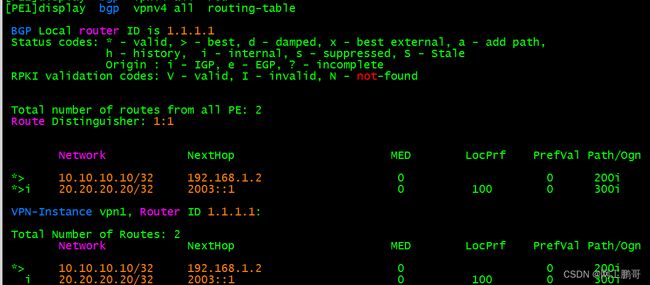SRV6 BE
实验目的:通过SRV6 BE实现CE之间的ipv4网络互访
步骤1:配置ISP网络设备的ipv6地址
步骤2:配置ISP网络的IGP协议(ISIS ipv6)设备配置前先在每台设备上面 undo dcn
PE1:
isis 1
cost-style wide
network-entity 49.0001.0000.0000.0001.00
ipv6 enable topology ipv6
interface Ethernet1/0/0
undo shutdown
ipv6 enable
ipv6 address 2001:12::1/64
isis ipv6 enable 1
interface LoopBack0
ipv6 enable
ipv6 address 2001::1/128
isis ipv6 enable 1PE2:
isis 1
cost-style wide
network-entity 49.0001.0000.0000.0002.00
ipv6 enable topology ipv6
interface LoopBack0
ipv6 enable
ipv6 address 2002::1/128
isis ipv6 enable 1
interface Ethernet1/0/0
ipv6 enable
ipv6 address 2001:12::2/64
isis ipv6 enable 1
interface Ethernet1/0/1
ipv6 enable
ipv6 address 2001:23::2/64
isis ipv6 enable 1PE3:
interface Ethernet1/0/0
undo shutdown
ipv6 enable
ipv6 address 2001:23::3/64
interface LoopBack0
ipv6 enable
ipv6 address 2003::1/64
isis ipv6 enable 1
isis 1
cost-style wide
network-entity 49.0001.0000.0000.0003.00
#
ipv6 enable topology ipv6步骤3:在PE设备上配置实例,PE设备与CE设备建立BGP邻居关系
PE1:
ip -instance 1 //创建实例
ipv4-family
route-distinguisher 1:1
-target 1:1 export-extcommunity
-target 1:1 import-extcommunity
interface Ethernet1/0/1 //将接口绑定实例
ip binding -instance 1
ip address 192.168.1.1 255.255.255.0
bgp 100 //配置与CE建立BGP邻居
ipv4-family -instance 1
peer 192.168.1.2 as-number 200PE2:
ip -instance 1
ipv4-family
route-distinguisher 1:1
-target 1:1 export-extcommunity
-target 1:1 import-extcommunity
interface Ethernet1/0/1
ip binding -instance 1
ip address 192.168.2.1 255.255.255.0
bgp 100//配置与CE建立BGP邻居
ipv4-family -instance 1
peer 192.168.2.2 as-number 300CE1:
bgp 200
peer 192.168.1.1 as-number 100
network 10.10.10.10 255.255.255.255CE2
bgp 300
peer 192.168.2.1 as-number 100
network 20.20.20.20 255.255.255.255配置完后PE上可以看到CE设备v4的路由
步骤4:配置PE1和PE2的v4邻居关系
PE1:
bgp 100
router-id 1.1.1.1//一定要配置router id ,bgp4+无法自动生成router id
peer 2003::1 as-number 100
peer 2003::1 connect-interface LoopBack0
ipv4-family v4
peer 2003::1 enablePE2:
bgp 100
router-id 2.2.2.2
peer 2001::1 as-number 100
peer 2001::1 connect-interface LoopBack0
ipv4-family v4
peer 2001::1 enable查看PE1的v4邻居以及路由表
可以看到对端的v4以及学习到了,但是没有放入实例的路由表中没有被优选。
没被优选的原因是由于隧道不可达,接下来配置srv6的隧道,用于传递CE之间的数据
步骤5:配置SRV6 BE
(1)开启SRv6功能,并且配置SRv6的locator
PE1:
segment-routing ipv6 //使能srv6功能
encapsulation source-address 2001::1//配置SRv6 VPN封装的源地址,一般使用bgp的更新源地址
locator pe1 ipv6-prefix 2001:ABCD:: 64 static 32 //配置静态locator的前缀为2001:ABCD::/64 取值范围为后32位PE2:
segment-routing ipv6
encapsulation source-address 2003::1
locator PE2 ipv6-prefix 2003:ABCD:: 64 static 32查看配置结果
(2)配置isis的srv6功能
PE1
isis 1
segment-routing ipv6 locator PE1 //使能isis的SRv6功能,利用isis通告locator的前缀路由PE2
isis 1
segment-routing ipv6 locator PE2(3)配置BGP的srv6功能
PE1:
Bgp 100
ipv4-family v4
peer 2003::1 prefix-sid //向对端pe通告路由的时候携带sid属性
ipv4-family -instance 1
segment-routing ipv6 locator PE1//使能VPN私网路由携带SID属性
segment-routing ipv6 best-effort //使能根据路由携带的SID属性进行私网路由迭代PE2:
Bgp 100
ipv4-family v4
peer 2001::1 prefix-sid
ipv4-family -instance 1
segment-routing ipv6 locator PE2
segment-routing ipv6 best-effort本地生成的sid,类似mpls中的私网标签,用于决定收到此dip时,发往哪一个实例
在CE1 ping CE2
ping -a 10.10.10.10 20.20.20.20
PING 20.20.20.20: 56 data bytes, press CTRL_C to break
Reply from 20.20.20.20: bytes=56 Sequence=1 ttl=253 time=40 ms
Reply from 20.20.20.20: bytes=56 Sequence=2 ttl=253 time=30 ms
Reply from 20.20.20.20: bytes=56 Sequence=3 ttl=253 time=40 ms
Reply from 20.20.20.20: bytes=56 Sequence=4 ttl=253 time=30 ms
Reply from 20.20.20.20: bytes=56 Sequence=5 ttl=253 time=30 ms 









